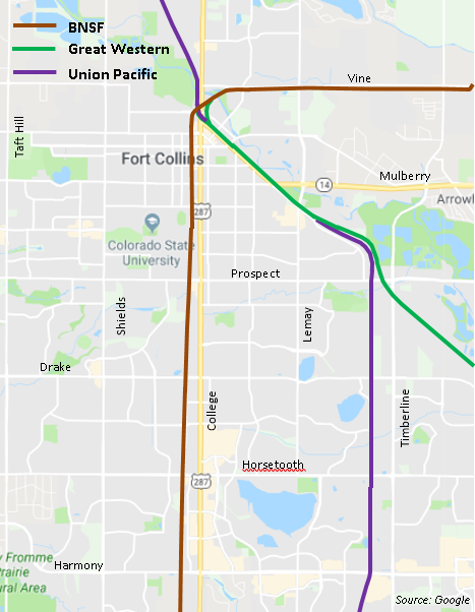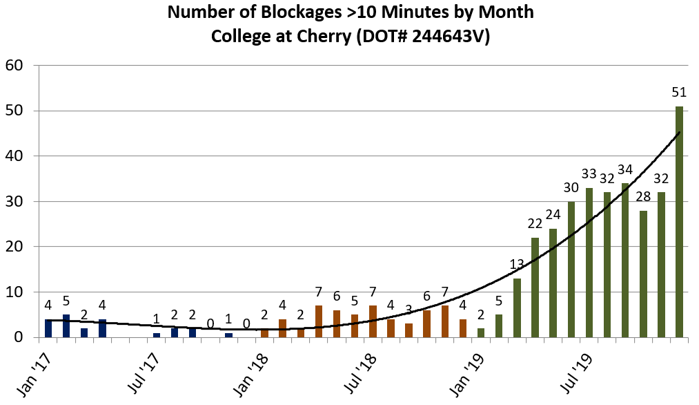Train Information#
Blocked Crossings#
The Federal Railroad Administration (FRA) is collecting data regarding blocked crossings. Click the link below to report a long blockage. Fort Collins is encouraging residents to submit reports anytime they are stopped by a train at a railroad crossing. Good and plentiful data from Fort Collins can help the FRA in studying the problem.
To report a blocked crossing, visit https://www.fra.dot.gov/blockedcrossings/.
Railroad lines in Fort Collins#

There are three railroads that have tracks through Fort Collins. The Burlington-Northern Santa Fe (BNSF) line runs parallel to College, then heads east along Vine Drive. The Great Western comes in from the east and runs along Riverside. The Union Pacific arrives from the south and runs parallel to Timberline before joining the Great Western line along Riverside.
Train Delays#
Historically, trains along the BNSF line have numbered about 8-10 per day and were usually up to one mile long (roughly 100 cars). Blockage times along the major east/west arterials west of College (Harmony, Horsetooth, Drake, Prospect, and Mulberry) were about 3 minutes, 30 seconds. Blockage times at Lemay / Vine could be longer due to the presence of the switching yard.
Starting in 2019, the BNSF began running longer trains. These are typically northbound trains carrying empty coal cars. They can be up to three miles long and block multiple major arterials simultaneously. Blockage times can exceed 15 minutes creating severe congestion and unexpected, long delays for residents.
At times, these long trains stop in Fort Collins as they wait for tracks to clear further north, or due to activity in the switching yard along Vine. Blockage times for these events can exceed 30 minutes. In November 2019, a person was seriously injured while attempting to climb between railcars of a long train when the train started moving after an extended stop.
As shown in the table and graph, the number of double trains and long blockages has increased exponentially.
| Month (2019) | No. of Double Trains |
|---|---|
| January | 1 |
| February | 0 |
| March | 3 |
| April | 0 |
| May | 11 |
| June | 12 |
| July | 19 |
| August | 18 |
| September | 15 |
| October | 0 |
| November | 16 |
| December | 32 |

What is the City doing?#
The issues with these long trains are concerning to the community as well as City leadership and staff. Because Fort Collins has no jurisdiction over trains, avenues other than regulation must be used to support change.
Providing Data#
City staff traveled to Washington, D.C. in January 2020 and met with the FRA's Director for Grade Crossing and Trespassing to express concern about the long trains. The FRA indicated that longer trains are a concern nationwide and they are collecting data to quantify impacts.
The FRA has developed a website (https://www.fra.dot.gov/blockedcrossings/) where people can report blocked crossings. Residents are encouraged to provide feedback to the FRA by using the website when they encounter long trains.
Coordination with elected officials#
City elected leadership is coordinating with our elected delegation in Washington to explore legislative options.
Lemay/Vine Overpass project#
The City opened the new Vine/Lemay Overpass to traffic in December 2021. Construction, landscaping, and art installation is expected to be complete later in 2022. Among the benefits, the new bridge will alleviate backups on old Lemay Avenue at the BNSF Railroad crossing near Vine Drive.
Wayside Horns#
The City’s Engineering and Traffic departments will test ‘wayside horns’ in downtown Fort Collins in March 2022 at the intersection of Mason Street and Mountain Avenue.
The test is part of the City’s efforts to investigate the use of wayside horns along the Mason Street corridor to reduce noise and improve quality of life for residents and businesses.
Wayside horns are permanently installed devices at railroad crossings that sound when a train is approaching. They have a lower noise impact than train-mounted horns and can be directed in the direction of oncoming traffic rather than in front of the train itself.
The City has not made a decision on whether or not to install wayside horns. The test is an early step in a multi-year process that will require approval by the Federal Railroad Administration. City staff will take decibel readings from the wayside horns and compare those to readings of existing train horns at the same location.
Quiet Zone#
The unique nature of the BNSF tracks through downtown Fort Collins along Mason results in a single train blowing their horn up to 48 times in the course of about three minutes along one mile of track. This requirement is often excessive and disruptive.
The City is pursuing the potential of creating a quiet zone that would allow flexibility in when / how often a train blows its horn.
Frequently Asked Questions#
-
No. The City has no jurisdiction over railroads, including when trains can move through the area, how long trains can be, or how many trains can move per day.
-
Railroad companies have government priority, always receiving the right-of-way. The best that Traffic Operations can do is to alleviate the back-up once a train has finished crossing at an intersection. The Traffic Management Center gives Traffic Operations the ability to monitor a train’s movement through town and adjust for any back-up that may occur.
-
Yes they are. The Federal Railroad Administration (FRA) regulates railroads, and they do not have maximum allowable length of a train.
-
Fort Collins could pass such an ordinance, but it would have no legal bearing
-
Residents are encouraged to submit a blocked crossing report to the FRA at https://www.fra.dot.gov/blockedcrossings/ when they encounter long delays. The FRA is collecting data on the long trains, and good and plentiful data from Fort Collins will help the FRA.
City leadership is working with elected officials in Washington on potential legislative options.
Work continues on the project to construct an overpass at the Lemay and Vine intersection.
-
Yes. The number of double trains through Fort Collins in 2019 increased from about 1 per month in January to more than 1 per day in December.
-
No. Never cross a stationary train! It is illegal to cross a stationary train at any location, and extremely dangerous. Also, it is considered trespassing to cross or be on the railroad tracks anywhere except at designated crossing locations whether a train is present or not.
-
No. Railroad companies do not publish train schedules. The time of day a train travels through Fort Collins is unpredictable.
-
Yes. The Federal Railroad Administration has created a website where the public can report being stopped at rail crossings. The website it http://www.fra.dot.gov/blockedcrossings.
-
Do not lift the railroad arms, as it is dangerous and illegal. Traffic Operations does not own or maintain this equipment and cannot lift the arms to allow traffic through. Call the City of Fort Collins Police Department non-emergency number at 221-6540 so that the proper railroad company can be notified.
-
Under an agreement with Burlington Northern Santa Fe Railroad (BNSF), MAX buses on the guideway, or bus-only street, are required to stop when a train passes. The railroad is concerned about safety on the guideway, which is within the railroad right-of-way. The railroad has between 4 to 8 trains running during MAX operating hours. There is no set schedule for when the trains travel through our community, which makes it difficult to anticipate their arrival. Passengers will experience delays of a few minutes to 10 minutes when the bus is held at a station due to the train. In the Downtown area and on McClelland Street, the bus is not required to stop for trains.